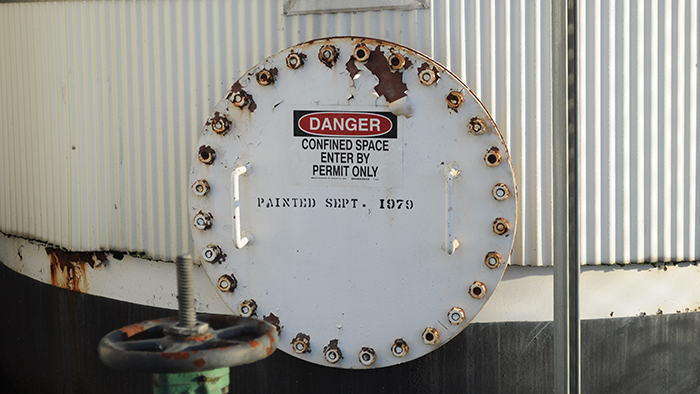Scrolling through social media this morning, did anyone else see the Ontario government’s sponsored ad for emergency preparedness? It was about ensuring people plan for emergencies such as having a plan with your family, build a supply kit of essentials, etc.
Now I’m sure this could have something to do with the media’s coverage of what is happening in Texas regarding the polar vortex, but I think we can all relate in the middle of a pandemic.
Throughout the last year in JHSC courses, I have had to opportunity to talk with many participants about the effects of the pandemic in terms of mental health issues, workplace safety procedures, and their own personal experiences when it comes to access to basics like food, and of course, the great Toilet Paper shortage of 2020.
What all of this has, or reinforced, is the need to have plans in place before a situation arises.
Now in terms of your home life, that really is on you, but let’s tie this into the workplace. What obligations does an employer have to ensure that their response would be fast, safe, and efficient if a problem arose? Where to start with such a topic? Wait for it… wait for it… Legislation!

Workplace Legislation
The Occupational Health and Safety Act (OHSA) should be no stranger to you if you have been reading these posts for any length of time.
We look to the green book for all the answers!
Well, just not the meaning of life, and I’m aware it’s actually not 42 (come on, that’s funny if you know the reference to the movie “The Hitchhikers guide to the galaxy”.) So, let’s start off with the duties of the employer.
Sections 25 and 26 of the OHSA cover the employer’s portion of the internal responsibility system or IRS, which in all reality bears the brunt of the obligations or at least the ultimate end of responsibility.
While it doesn’t specifically list that an employer has to prepare for all emergencies that arise directly, it does secondarily through other means.
S.25 (1) (c) states:
“An employer shall (must) ensure that the measures and procedures prescribed (by regulations under this act) are carried out in the workplace.”
Now that it specifies regulation, we have to consider where you work. If you go onto e-laws and find your industry’s regulation, hit ctrl + f (find), then type in emergency.
- Reg 851 (Industrial Establishments) will list estops on machines S.27, guards for shifting loads S.55, procedures for situations concerning molten metal S.87.6, rules for logging vehicles S.116, industrial hygiene such as eyewash and showers in S.124, and emergency measures for exposure to biological, chemical, or physical agents S.130.
- Reg 213 (Construction) pops up with 34 hits, starting off with what seems to be missing from industrial. S. 17(1) states, “A constructor shall establish for a project written procedures to be followed in the event of an emergency and shall ensure that the procedures are followed at the project.” A universal obligation to prepare for whatever may happen. Specifically, we can find directions including access and egress S.71, suspended platforms S.138, underground workers S.264, to name a few.
- Reg 67 (Health Care) only comes up with 7 entries for the word emergency. Measures and procedures are required explicitly for restricted spaces S.42, estops on equipment S.48, autoclaves S.60, suspended scaffolds S.91, and exposure to antineoplastic drugs (chemotherapy) S.97.
So, unless we are in construction, there doesn’t seem to be a general clause that states the employer has to protect its workers in non-prescribed emergency situations – or is there? Well, of course!
OHSA S.25 (2)(h) “an employer shall take every precaution reasonable in the circumstances for the protection of a worker,” emergency preparedness can fall under due diligence.
Hopefully, after getting this far, we can all agree that emergency preparedness just magically became the employer’s responsibility. You’re welcome, by the way – now let’s get to work.
Emergency Preparedness
Firstly, let’s define “emergency.”
The Oxford English Dictionary defines it as
“a sudden serious and dangerous event or situation which needs immediate action to deal with it.”
Realistically that tells me we are talking about a hazard. In the workplace, that means it’s time to recognize, assess, control, and evaluate!
If a problem isn’t recognized, we can’t plan or guarantee the desired reaction. We need to ensure that adequate precautions are taken to familiarize individuals with their responsibilities should an emergency occur.
Suppose employers/supervisors/workers are not familiar with their roles and responsibilities in emergency response. In that case, it can cause confusion when these individuals must make rapid decisions in short periods (without all desired information).
In addition, they may be dealing with the lack of necessary resources (First-aid kits, extinguishers), lack of individuals trained in emergency response (First-aid, extinguisher use), and lack of cooperation from fellow workers and management.
These responsibilities need to be clearly defined in order to provide proper direction.
Emergency preparedness should already be a consideration.
If you look in your organization’s Health and Safety program, remember it is legally required that “the employer shall prepare and review at least annually a written occupational health and safety policy and develop and maintain a program to implement that policy” OHSA 25. (2)(j).
Remember that you signed off that you read in its entirety when you got hired? Yeah, that one!
It should list procedures for fire safety, evacuation, severe weather, natural disaster, medical emergency, chemical spill, flood/water loss, gas leak, power failure, communications loss, workplace violence, workplace harassment, robbery prevention, heat/cold stress, and more depending on your industry.
The purpose of these procedures is to ensure all parties of the IRS can recognize these hazards and be trained on the contents, including risk assessments and the hierarchy of controls that have been put in place to protect workers. Controls can include engineering or at the source controls:
- Having fire hoses installed
- Providing more fire extinguishers than required
- Have first-aid kits available at multiple locations to avoid panic in finding one
- Designing the work area to allow for easy exit in the event of an emergency
- Using flashing lights to indicate a need to follow an emergency procedure
- Installing a PA system used to inform workers of emergencies
- Providing ample means of communication for 911
Or along the path controls, otherwise known as administrative:
- Implementing procedures for all potential emergencies
- Ensuring that workers are trained in these procedures at least annually
- Ensuring emergency plans have one person in charge, typically called the Emergency Plan Coordinator
- Ensuring the Emergency Plan Coordinator is aware of their responsibilities
- Completing an emergency plan risk assessment to determine the gaps and fix them
- Installing signage to warn individuals and provide the necessary information (exit signs, first aid signs, no running signs, etc.)
- Completing practical evaluations of emergency procedures (Annual Fire drills) to determine the adequacy
So, does your company have any of these in place?
Has your company identified all situations that may require emergency response procedures?
If so, great! But if not, perhaps there is some work to be done.
Take inventory of the tasks that may require an emergency response, then determine which have a response procedure, and if that procedure will work. If certain tasks do not have a procedure, or if the existing procedure may not work, then you know what needs to be done!
Need some help? That’s what we’re here for.
When considering emergency preparedness at work, or at home, it takes a lot of effort. I hope going through the employer’s obligations under the OHSA has given you some food for thought!
If all of this is bang on with what your organization has in place – kudos! Being prepared brings to mind a few phrases, such as “better looking at it than for it” or “knowing is half the battle” (that’s right, I referenced GI Joe).
However, after reading this, if you think that your company may need to do a little work on this, remember you have a JHSC; they are always willing to help.
In closing, who would have thought a sponsored social media post would have led us down this rabbit hole? Man, I need to get out more.
Geoff Rowatt
Health & Safety Trainer | CHRP | CHRL





